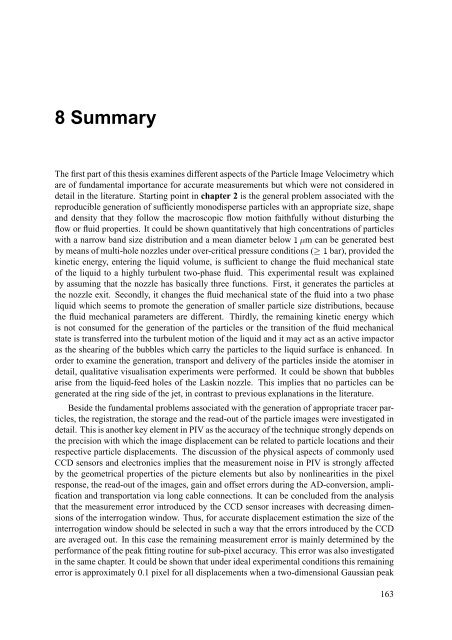The significance of coherent flow structures for the turbulent mixing ...
The significance of coherent flow structures for the turbulent mixing ...
The significance of coherent flow structures for the turbulent mixing ...
Create successful ePaper yourself
Turn your PDF publications into a flip-book with our unique Google optimized e-Paper software.
¿<br />
8 Summary<br />
<strong>The</strong> first part <strong>of</strong> this <strong>the</strong>sis examines different aspects <strong>of</strong> <strong>the</strong> Particle Image Velocimetry which<br />
are <strong>of</strong> fundamental importance <strong>for</strong> accurate measurements but which were not considered in<br />
detail in <strong>the</strong> literature. Starting point in chapter 2 is <strong>the</strong> general problem associated with <strong>the</strong><br />
reproducible generation <strong>of</strong> sufficiently monodisperse particles with an appropriate size, shape<br />
and density that <strong>the</strong>y follow <strong>the</strong> macroscopic <strong>flow</strong> motion faithfully without disturbing <strong>the</strong><br />
<strong>flow</strong> or fluid properties. It could be shown quantitatively that high concentrations <strong>of</strong> particles<br />
with a narrow band size distribution and a mean diameter below m can be generated best<br />
by means <strong>of</strong> multi-hole nozzles under over-critical pressure conditions ¿:9 bar), provided <strong>the</strong><br />
(;<br />
kinetic energy, entering <strong>the</strong> liquid volume, is sufficient to change <strong>the</strong> fluid mechanical state<br />
<strong>of</strong> <strong>the</strong> liquid to a highly <strong>turbulent</strong> two-phase fluid. This experimental result was explained<br />
by assuming that <strong>the</strong> nozzle has basically three functions. First, it generates <strong>the</strong> particles at<br />
<strong>the</strong> nozzle exit. Secondly, it changes <strong>the</strong> fluid mechanical state <strong>of</strong> <strong>the</strong> fluid into a two phase<br />
liquid which seems to promote <strong>the</strong> generation <strong>of</strong> smaller particle size distributions, because<br />
<strong>the</strong> fluid mechanical parameters are different. Thirdly, <strong>the</strong> remaining kinetic energy which<br />
is not consumed <strong>for</strong> <strong>the</strong> generation <strong>of</strong> <strong>the</strong> particles or <strong>the</strong> transition <strong>of</strong> <strong>the</strong> fluid mechanical<br />
state is transferred into <strong>the</strong> <strong>turbulent</strong> motion <strong>of</strong> <strong>the</strong> liquid and it may act as an active impactor<br />
as <strong>the</strong> shearing <strong>of</strong> <strong>the</strong> bubbles which carry <strong>the</strong> particles to <strong>the</strong> liquid surface is enhanced. In<br />
order to examine <strong>the</strong> generation, transport and delivery <strong>of</strong> <strong>the</strong> particles inside <strong>the</strong> atomiser in<br />
detail, qualitative visualisation experiments were per<strong>for</strong>med. It could be shown that bubbles<br />
arise from <strong>the</strong> liquid-feed holes <strong>of</strong> <strong>the</strong> Laskin nozzle. This implies that no particles can be<br />
generated at <strong>the</strong> ring side <strong>of</strong> <strong>the</strong> jet, in contrast to previous explanations in <strong>the</strong> literature.<br />
Beside <strong>the</strong> fundamental problems associated with <strong>the</strong> generation <strong>of</strong> appropriate tracer particles,<br />
<strong>the</strong> registration, <strong>the</strong> storage and <strong>the</strong> read-out <strong>of</strong> <strong>the</strong> particle images were investigated in<br />
detail. This is ano<strong>the</strong>r key element in PIV as <strong>the</strong> accuracy <strong>of</strong> <strong>the</strong> technique strongly depends on<br />
<strong>the</strong> precision with which <strong>the</strong> image displacement can be related to particle locations and <strong>the</strong>ir<br />
respective particle displacements. <strong>The</strong> discussion <strong>of</strong> <strong>the</strong> physical aspects <strong>of</strong> commonly used<br />
CCD sensors and electronics implies that <strong>the</strong> measurement noise in PIV is strongly affected<br />
by <strong>the</strong> geometrical properties <strong>of</strong> <strong>the</strong> picture elements but also by nonlinearities in <strong>the</strong> pixel<br />
response, <strong>the</strong> read-out <strong>of</strong> <strong>the</strong> images, gain and <strong>of</strong>fset errors during <strong>the</strong> AD-conversion, amplification<br />
and transportation via long cable connections. It can be concluded from <strong>the</strong> analysis<br />
that <strong>the</strong> measurement error introduced by <strong>the</strong> CCD sensor increases with decreasing dimensions<br />
<strong>of</strong> <strong>the</strong> interrogation window. Thus, <strong>for</strong> accurate displacement estimation <strong>the</strong> size <strong>of</strong> <strong>the</strong><br />
interrogation window should be selected in such a way that <strong>the</strong> errors introduced by <strong>the</strong> CCD<br />
are averaged out. In this case <strong>the</strong> remaining measurement error is mainly determined by <strong>the</strong><br />
per<strong>for</strong>mance <strong>of</strong> <strong>the</strong> peak fitting routine <strong>for</strong> sub-pixel accuracy. This error was also investigated<br />
in <strong>the</strong> same chapter. It could be shown that under ideal experimental conditions this remaining<br />
error is approximately 0.1 pixel <strong>for</strong> all displacements when a two-dimensional Gaussian peak<br />
163
















